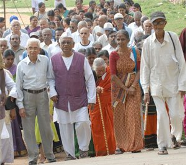 The government is actively considering raising the retirement age of all central government employees, including those in the armed forces, from the present 60 to 62 years, reports Aditi Phadnis.
The government is actively considering raising the retirement age of all central government employees, including those in the armed forces, from the present 60 to 62 years, reports Aditi Phadnis.
Finance Minister Pranab Mukherjee has submitted a report to the prime minister outlining all the pros and cons of the move, including the cascading effects on government employment and the huge savings, at least for two years, on account of retirement payouts.
If the Department of Personnel and Training (DoPT) and the prime minister find the arguments forwarded by the finance ministry credible and convincing, the announcement may come as early as August 15, as part of Manmohan Singhs Independence Day speech.
The Cabinet may discuss the matter on Thursday.
Although the finance ministry is making a strong case for the move, the DoPT is taking time to make up its mind, possibly out of consideration for the 1979 batch of the Indian Administrative Service (IAS) and other central services.
Officers of the 1979 batch have been empanelled for promotion to the ranks of additional secretary and secretary but can take up their posts only after the present incumbents retire.
If an announcement extending the retirement age comes before November, a batch of empanelled joint secretaries stand to lose their future ranks. In turn, this will also affect those who joined the central administrative services in 1980.
The DoPT also says that the age profile of Indian bureaucrats, instead of becoming younger, will become older, out of tune with the rest of the world.
For the finance ministry, the gains from the move are clear. The pension payout of all armed forces personnel of the rank of Lieutenant General and equivalent who were to retire this year will be postponed by 24 months; the government will also defer by two years the liability of paying pension to more than 100,000 employees. While salaries will have to continue to be paid, this will be cheaper than paying upfront benefits like gratuity.
This is all the more important given the governments other financial liabilities on account of stimulus spending and one drought, though the effects of the latter will kick in only in the next fiscal year.
The fiscal deficit is 6.8 per cent of gross domestic product this year and a two-year lag in paying pensions will help in bridging this.
In 1998, the National Democratic Alliance government had raised the retirement age from 58 to 60, a move that benefitted 90,000 government servants and 50,000 defence personnel.
At the time, the logic was: the retirement of 140,000 employees would have cost Rs 5,200 crore (Rs 52 billion) whereas paying salaries cost only Rs 1,493 crore (Rs 14.93 billion).
That move came in the wake of the 5th Pay Commission report which had just been implemented by the then United Front government. In 2003, the government also right-sized the central government employee workforce by 30 per cent.
Every time the Centre announces an increase or concession on pay packages, both public-sector units and state governments follow suit. If the prime minister does decide to raise the retirement age, state governments and Public Sector Units (PSUs) will mirror this action. This has its own implications for many cash-strapped states like Punjab.
If the decision is finally taken, it will only be the third time the government will have raised the retirement age. Jawaharlal Nehru was the first prime minister to have increased the age of superannuation from 55 to 58 following the 1962 war with China. The Atal Bihari Vajpayee government did it a second time in 1998.








